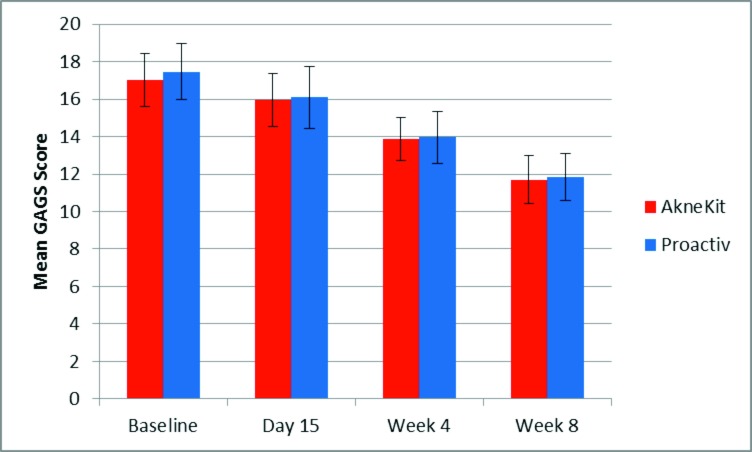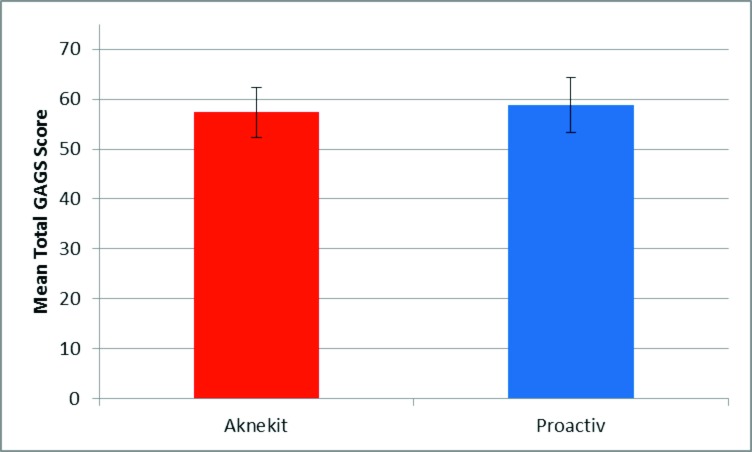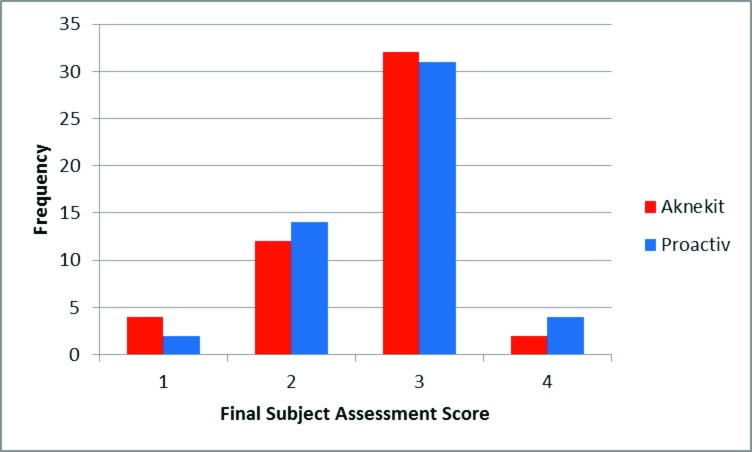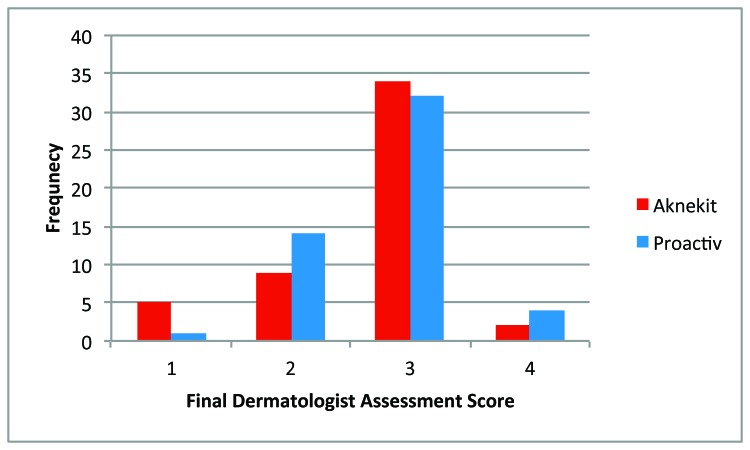Abstract
Objective:To evaluate the efficacy and tolerability of a novel hydrogen peroxide-based regimen versus a benzoyl peroxide-based regimen in mild-to-moderate acne. Methods: In this eight-week multicenter study, patients were randomized to either a hydrogen peroxide-based or a benzoyl peroxide-based regimen.The primary outcome measure of clinical response was assessed using the Global Acne Grading System (GAGS) at baseline,four weeks, and eight weeks. At Week 8, a patient self-satisfaction questionnaire was administered. Investigators were also queried at that time regarding assessment of tolerability and cosmetic acceptability. Tolerability was also measured at each visit. Results: Both treatment regimens were associated with improvement of GAGS score at Week 8 compared to baseline (p<0.0001). GAGS score did not differ significantly between the two regimens over the same period (p=0.7765). No significant adverse events were reported or observed in either treatment arm. Both patients and investigators found both regimens to be similarly effective and cosmetically acceptable. Conclusion: A novel hydrogen peroxide-based regimen was shown to be comparable in efficacy, safety, and cosmetic acceptability to a benzoyl peroxide-based regimen in the treatment of mild-to-moderate acne.
IN THE FIRST GLOBAL ALLIANCE therapeutic guidelines of acne published in 2003, benzoyl peroxide (BP) was considered the first choice in mild and moderate papulopustular acne as well as in moderate nodular acne.1 This statement was substantially confirmed in the second Global Alliance publication in 2009.2 In the European evidence-based guidelines, BP, associated with adapalene (A) or clindamycin, got a high strength of recommendation in mild-to-moderate papulopustular acne.3 However, irritant contact dermatitis is a frequent side effect of BP.4 It occurs in approximately 40 percent of patients and is clinically similar to irritant contact dermatitis caused by topical retinoids, although less severe.4 This dermatitis is characterized mainly by dryness and erythema.4 Allergic contact dermatitis caused by BP is uncommon in acne patients; however, its incidence is likely underestimated.4 The authors present the results of a multicenter, randomized, controlled trial of a hydrogen peroxide (HP)-based kit versus a BP-based kit in mild-to-moderate acne.
PATIENTS AND METHODS
This eight-week clinical study was carried out at two Italian dermatologic departments (Catania and Rome). Patients were randomized with 1:1 assignment to either the HP-based or BP-based regimens. All procedures in this study were followed in accordance with site institutional review standards and the principles of the Helsinki Declaration of 1975, as revised in 2000 and 2008.
One hundred and twenty male and female patients between the ages of 14 and 40 years in otherwise good health with mild-to-moderate acne were selected and consented for enrollment, and were randomized to a respective treatment arm. Exclusion criteria included pregnancy and lactation, known hypersensitivity to components of the kits, and current use of topical and oral anti-acne drugs. No other topical and/or systemic drugs were allowed, except for sunscreens. A washout period of 30 days for oral anti-acne drugs and 15 days for topical therapies was enforced. Patients were randomized, and both they and the dermatologists who rated the study were blinded as to assignment. The same dermatologist rated each patient each time. Patients received treatment with either the HP-based regimen or the BP-based regimen. At the initial visit, patients were given an acne treatment kit and were instructed by the investigator on the correct use of the products. In addition to baseline assessment, patients were assessed and evaluated for efficacy and safety at Day 15 and Weeks 4 and 8. Each patient was assessed using the Global Acne Grading System (GAGS)5 (Table 1) to gauge aggregate severity based on local scores from the face and non-facial locations (chest, shoulders, and back). The assessment of acne in a given anatomic location (local score) considers a factor based on surface area, distribution, and number of acne lesions multiplied by a numeric grade, expressed on a severity scale of 0 to 4 depending on the type of lesions observed. GAGS overall score was then computed by addition of all local scores. GAGS overall score range designations were as follows: mild acne (1–18), moderate (19–30), severe (31–38), very severe (>39) (Table 1). End-of-treatment efficacy evaluation was also performed by physicians and patients at Week 8 (rating range: 1–4) (Table 2). End-of-treatment cosmetic acceptability evaluation (based on the characteristics of fragrance, consistency, and product absorption) was assessed by patients.
TABLE 1.
Global Acne Grading System score calculation
| AREA | FACTOR | GRADE* | LOCAL SCORE (FACTOR X GRADE) |
|---|---|---|---|
| Forehead | 2 | 0–4 | 2 x (Grade) |
| Right cheek | 2 | 0–4 | 2 x (Grade) |
| Left cheek | 2 | 0–4 | 2 x (Grade) |
| Nose | 1 | 0–4 | 1 x (Grade) |
| Chin | 1 | 0–4 | 1 x (Grade) |
| Chest, shoulders, back | 3 | 0–4 | 3 x (Grade) |
Grade for a given site was determined upon presence of the following: 0-no acne lesions; 1-comedones; 2-papules; 3-pustules; 4-nodules. For each patient, a total GAGS overall score was then computed by addition of all local scores
TABLE 2.
End-of-treatment efficacy evaluation
| SCORE | ASSOCIATED EFFICACY |
|---|---|
| 1 | No efficacy |
| 2 | Poor efficacy |
| 3 | Good efficacy |
| 4 | Excellent efficacy |
Each acne kit comprised three products. Active ingredients for the fragrance-free proprietary Aknekit® (BMG Pharma, Milan, Italy) line were as follows: “Purifying Cleanser” (2% salicyclic acid, 0.5% glycolic acid and 0.5% urea peroxide), “Day Treatment” (0.9% HP and 0.1% hyaluronic acid), and “Night Treatment” (0.3% Krameria triandra root extract, 0.05% glycolic acid and 0.05% kojic acid). Active ingredients of the proprietary Proactiv® line included “Renewing Cleanser” (2.5% BP), “Revitalizing Toner” [0.05% glycolic acid and Hamamelis virginiana (witch hazel)], and “Repairing Treatment” (2.5% BP). Patients in the HP-based arm applied the “Day Lotion” in the morning and the “Night Treatment” in the evening. In the BP-based arm, patients applied the “Revitalizing Toner” and the “Repairing Treatment” twice daily. In both groups, cleansers were used in the morning and at night. The adjustments. Median physician and subject end-of-treatment efficacy evaluations were compared between the two treatment arms using the Wilcoxon rank sum test since data was ordinal.
RESULTS
In all patients, the face was involved. In one patient, the back was also involved. One hundred and three patients (85.8%) completed all study procedures and follow-up visits. Seventeen patients stopped the trial for personal reasons; none of the patients stopped the treatment because of adverse events. Skin phototypes were in the range of I to III. The primary outcome of this study was the degree of clinical response to treatment with the HP-based and the BP-based regimens, according to the GAGS score. Inter-group comparison demonstrated that mean GAGS overall scores (combining time points) did not differ significantly between the two treatment groups (p=0.7765); mean GAGS overall scores did not differ significantly between treatments and over time (p=0.9922). In summary, both acne treatments were effective and were associated with significant improvement of GAGS overall scores at Week 8 compared with baseline (Figure 1). There was no significant difference in efficacy between the two acne regimens (Figure 2).
Figure 1.
Mean GAGS overall scores over time
Figure 2.
Mean of the sum of GAGS overall scores across all time points
Secondary outcomes included patient and physician perceptions about efficacy and cosmetic acceptability. Comparison of end-of-treatment efficacy evaluations found both acne regimens to be effective and cosmetically pleasing. No significant difference was observed across treatment arms (patient evaluation:p=0.6994; physician evaluation:p=0.6565) (Figures 3 and 4). No significant adverse events were reported or observed in either treatment arm.
Figure 3.
Patient end-of-treatment efficacy evaluation
Figure 4.
Physician end-of-treatment efficacy evaluation
DISCUSSION
The first study on the treatment of acne with HP was published in 1987.6 Subsequently, three trials were published.7-9 Milani et al7 studied a 1% HP cream. In a randomized, prospective trial, 60 patients were enrolled. HP or 4% BP gel was applied twice daily for eight weeks. The study endpoints were reduction in mean total, noninflammatory and inflammatory lesions in comparison with baseline and tolerability. HP was as effective as BP in reducing both noninflammatory and inflammatory lesions. However, 1 % HP cream showed a better tolerability profile.7
Capizzi et al8 evaluated the efficacy and tolerability of the combination 1% HP cream and 0.1% adapalene gel in comparison with the combination 4% BP cream and 0.1% adapalene gel. Fifty-two patients were randomly assigned to HP cream and adapalene gel (group HP/adapalene) or to BP cream and adapalene gel (group BP/adapalene), for eight weeks. Efficacy was assessed by total, inflammatory and noninflammatory lesion count performed at baseline and Weeks 4 and 8. Tolerability was also assessed. A significantly greater reduction in noninflammatory lesions was observed in the HP/adapalene group. Also tolerability was significantly better in the HP/adapalene group.
More recently, Muizzuddin et al9 developed a new HP system using the enzyme glucose oxidase and glucose. According to the authors, this system is stable. In a short-term (four days) clinical study, this formulation was effective in reducing the single lesion size and total number of inflammatory lesions. There was a 68-percent reduction in inflammatory lesions and 61-percent reduction in acne lesion size within four days of treatment. A six-week clinical study displayed a 56-percent reduction in total number of inflammatory lesions and 45-percent reduction in noninflammatory lesions.
Results of the authors’ study (multicenter and based on a high number of evaluable patients) may be summarized as follows: 1) this HP-based regimen was comparable in efficacy to the BP-based regimen in the treatment of mild-to-moderate acne; 2) tolerability was very good (as previously mentioned, no significant adverse events were reported or observed; this very good tolerability allowed a high adherence of patients to the treatment); 3) cosmetic acceptability was judged by the patients as good.
The main mechanism of action of HP in acne is similar to that of BP: It reduces Propionibacterium acnes colonization.7,8 A theoretic future of topical HP may be represented by its use in atrophic acne scars. Since the 1990s, it was demonstrated that oxygen free radicals can both stimulate and inhibit proliferation of cultured human fibroblasts and that fibroblasts themselves release superoxide free radicals. Fibroblasts release superoxide free radicals in concentrations that stimulate proliferation, a finding confirmed by a dose-dependent inhibition of proliferation by free radical scavengers. Oxygen free radicals released by a host of agents may thus provide a very fast, specific, and sensitive trigger for fibroblast proliferation. Prolonged stimulation may result in fibrosis.10 Normally, the repair process in the skin begins with an inflammatory response. However, one of the most important aspects of scarless fetal wound repair appears to be a lack of inflammation, suggesting that inflammation promotes scar formation in the skin. While it is well accepted that inflammation causes scar formation in the fetus, it is not known what specific factors produced during inflammation are responsible for these effects. Oxidants released by activated inflammatory cells have the potential to be involved. An experimental study, using a murine fetal wound repair model, showed that HP interferes with scarless healing, possibly through the induction of transforming growth factor-α. HP also increased the proliferation of fetal fibroblasts, which could contribute to an increase in the fibrosis observed with HP.11
Footnotes
Disclosure:Drs. Veraldi, Micali, Dall’Oglio, Sinagra, and Elena Guanziroli report no relevant conflicts of interest. Dr. Berardesca is a consultant dermatologist for BMG Pharma, Milan, Italy.
REFERENCES
- 1.Gollnick H, Cunliffe W. Management of acne: a report from a global alliance to improve outcomes in acne. J Am Acad Dermatol. 2003;49:(1 Suppl):S1–S37. doi: 10.1067/mjd.2003.618. [DOI] [PubMed] [Google Scholar]
- 2.Thiboutot D, Gollnick H. New insights into the management of acne: an update from the Global Alliance to improve outcomes in acne group. J Am Acad Dermatol. 2009;60:(5 Suppl):S1–S50. doi: 10.1016/j.jaad.2009.01.019. [DOI] [PubMed] [Google Scholar]
- 3.Nast A, Dréno B, Bettoli V, et al. European evidence-based (S3) guidelines for the treatment of acne. J Eur Acad Dermatol Venereol. 2012;26(Suppl 1):1–29. doi: 10.1111/j.1468-3083.2011.04374.x. [DOI] [PubMed] [Google Scholar]
- 4.Veraldi S, Brena M, Barbareschi M. Allergic contact dermatitis caused by topical antiacne drugs. Exp Rev Clin Pharmacol. 2015;17:1–5. doi: 10.1586/17512433.2015.1046839. [DOI] [PubMed] [Google Scholar]
- 5.Doshi A, Zaheer A, Stiller MJ. A comparison of current acne grading systems and proposal of a novel system. Int J Dermatol. 1997;36:416–418. doi: 10.1046/j.1365-4362.1997.00099.x. [DOI] [PubMed] [Google Scholar]
- 6.Haustein UF, Ziegler B. Treatment of acne vulgaris with hydrogen peroxide emulsion (L/W) Dermatol Monatsschr. 1987;173:323–327. [PubMed] [Google Scholar]
- 7.Milani M, Bigardi A, Zavattarelli M. Efficacy and safety of stabilized hydrogen peroxide cream (Crystacide®) in mil-to-moderate acne vulgaris: a randomized, controlled trial versus benzoyl peroxide gel. Curr Med Res Opin. 2003;19:135–138. doi: 10.1185/030079902125001523. [DOI] [PubMed] [Google Scholar]
- 8.Capizzi R, Landi F, Milani M, et al. Skin tolerability and efficacy of combination therapy with hydrogen peroxide stabilized cream and adapalene gel in comparison with benzoyl peroxide cream and adapalene gel in common acne. A randomized, investigator-masked, controlled trial. Br J Dermatol. 2004;151:481–484. doi: 10.1111/j.1365-2133.2004.06067.x. [DOI] [PubMed] [Google Scholar]
- 9.Muizzuddin N, Schnittger S, Maher W, et al. Enzymatically generated hydrogen peroxide reduces the number of acne lesions in acne vulgaris. J Cosmet Sci. 2013;64:1–8. [PubMed] [Google Scholar]
- 10.Murrell GA, Francis MJ, Bromley L. Modulation of fibroblast proliferation by oxygen free radicals. Biochem J. 1990;265:659–665. doi: 10.1042/bj2650659. [DOI] [PMC free article] [PubMed] [Google Scholar]
- 11.Wilgus TA, Bergdall VK, Dipietro LA, et al. Hydrogen peroxide disrupts scarless fetal wound repair. Wound Repair Regen. 2005;13:513–519. doi: 10.1111/j.1067-1927.2005.00072.x. [DOI] [PubMed] [Google Scholar]






